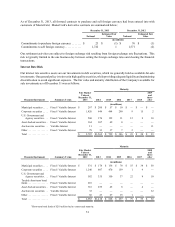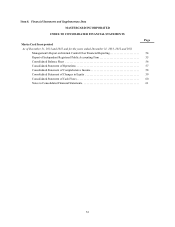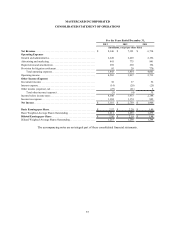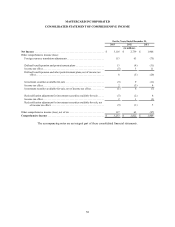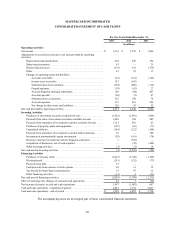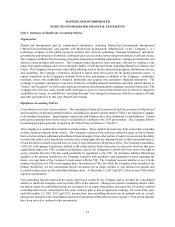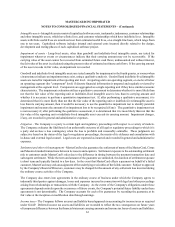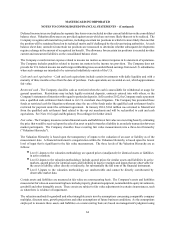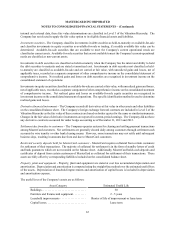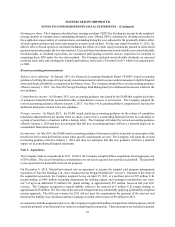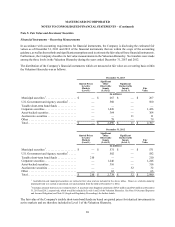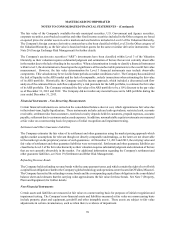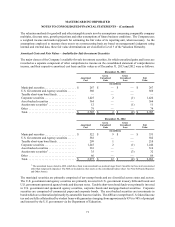MasterCard 2013 Annual Report Download - page 65
Download and view the complete annual report
Please find page 65 of the 2013 MasterCard annual report below. You can navigate through the pages in the report by either clicking on the pages listed below, or by using the keyword search tool below to find specific information within the annual report.61
MASTERCARD INCORPORATED
NOTES TO CONSOLIDATED FINANCIAL STATEMENTS
Note 1. Summary of Significant Accounting Policies
Organization
MasterCard Incorporated and its consolidated subsidiaries, including MasterCard International Incorporated
(“MasterCard International” and together with MasterCard Incorporated, “MasterCard” or the “Company”), is a
technology company in the global payments industry that connects consumers, financial institutions, merchants,
governments and businesses worldwide, enabling them to use electronic forms of payment instead of cash and checks.
The Company facilitates the processing of payment transactions including authorization, clearing and settlement, and
delivers related products and services. The Company makes payments easier and more efficient by creating a wide
range of payment solutions and services through a family of well-known brands, including MasterCard, Maestro and
Cirrus. The Company also provides value-added offerings such as loyalty and reward programs, information services
and consulting. The Company’s network is designed to ensure safety and security for the global payments system. A
typical transaction on the Company's network involves four participants in addition to the Company: cardholder,
merchant, issuer (the cardholder’s financial institution) and acquirer (the merchant’s financial institution). The
Company's customers encompass a vast array of entities, including financial institutions and other entities that act as
"issuers" and "acquirers", as well as merchants, governments, telecommunication companies and other businesses. The
Company does not issue cards, extend credit, determine or receive revenue from interest rates or other fees charged to
cardholders by issuers, or establish the “merchant discount” rate charged in connection with the acceptance of cards
and other payment devices that carry MasterCard's brands.
Significant Accounting Policies
Consolidation and basis of presentation - The consolidated financial statements include the accounts of MasterCard
and its majority-owned and controlled entities, including any variable interest entities ("VIEs") for which the Company
is the primary beneficiary. Intercompany transactions and balances have been eliminated in consolidation. Certain
prior period amounts have been revised or reclassified to conform to the 2013 presentation. The Company follows
accounting principles generally accepted in the United States of America (“GAAP”).
The Company is a variable interest holder in certain entities. These variable interests arise from contractual, ownership
or other monetary interests in the entities. The Company evaluates if the entity has sufficient equity at risk to finance
their activities without additional subordinated financial support from other parties, if equity investors lack the ability
to control the entity's most significant activities, have voting rights that are disproportionate to their ownership interest,
or lack the ability to absorb expected losses or receive expected returns (referred to as VIEs). The Company consolidates
a VIE if it is the primary beneficiary, defined as the entity that has both (i) the power to direct the activities that most
significantly impact the VIE's economic performance and (ii) the obligation to absorb the losses and/or the right to
receive benefits from the VIE that could potentially be significant to the VIE. To determine whether MasterCard
qualifies as the primary beneficiary, the Company considers both qualitative and quantitative factors regarding the
nature, size and form of the Company's involvement with the VIE. The Company assesses whether or not it is the
primary beneficiary of a VIE on an ongoing basis. Investments in VIEs for which the Company is not considered the
primary beneficiary are not consolidated and are accounted for as equity method or cost method investments and
recorded in other assets on the consolidated balance sheet. At December 31, 2013 and 2012, there were no VIEs which
required consolidation.
Non-controlling interests represent the equity interest not owned by the Company and is recorded for consolidated
entities in which the Company owns less than 100% of the interests. Changes in a parent's ownership interest while
the parent retains its controlling interest are accounted for as equity transactions, and upon loss of control, retained
ownership interests are remeasured at fair value, with any gain or loss recognized in earnings. For each of the years
ended December 31, 2013, 2012 and 2011, income from non-controlling interests was de minimis and, as a result,
amounts are included in the consolidated statement of operations within other income (expense). Prior period amounts
have been revised to conform to this presentation.


